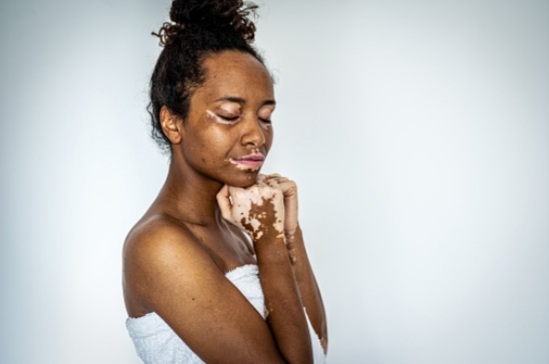Vitiligo is a condition that results in the skin losing its color.
Contrary to popular beliefs and opinions, this disorder is not peculiar to any specific race and can affect people of any color. However, it is more noticeable on black skin because of the glaring contrast between the patches and the actual skin complexion.
According to the official website of the National Institute of Arthritis and Musculoskeletal and Skin Diseases, NIAMS, this condition is an autoimmune disease that comes about when the immune system starts to attack melanocytes, the cells responsible for pigmentation, thereby killing them off.
Usually, our immune system acts as the body’s defence mechanism that helps repel external attacks, but in the case of vitiligo or other autoimmune conditions, the immune system ends up mistaking the body’s own cells for enemies and attacking them.
According to online portal, Everydayhealth, vitiligo can be divided into two major types: segmental and non-segmental vitiligo.
Segmental vitiligo manifests with milky-white patches appearing on just a side of the body instead of both parts, i.e. one arm, one leg, a single ear, etc.
This vitiligo type most times begins in childhood and then stops after spreading for a couple of months to about two years. In some rare instances, it could resume spreading later in the future.
Segmental vitiligo accounts for about five to 16% of vitiligo cases and has loss of hair as one of its most consistent features.
Non-segmental vitiligo accounts for the larger chunk of the overall vitiligo statistics. It appears with bleached pale skin patches on any part of the body, i.e., hands, legs, ears, etc., and areas like the eyes, fingertips, wrists, and toes are mostly the first to be affected.
This type of vitiligo is divided into various subtypes, depending on the way they manifest. For instance, while acrofacial vitiligo affects the face and limbs, mucosal impacts the mucosal membranes of the nose, mouth, and genitals.
Localized vitiligo affects just a few areas of the body. This type can also be called focal vitiligo, while universal vitiligo may likely go on to impact as much as 80% – 90% of the body.
Causes and risk factors
While it is a well-known fact that vitiligo comes about when the melanocytes responsible for pigmentation are attacked by the autoimmune system, the actual reason or cause of the condition is still unknown.
However, research has discovered some risk factors that can contribute to or increase one’s chances of having vitiligo.
Some of them are:
• Autoimmune diseases like vitiligo and others – especially those affecting the thyroid glands — have been discovered to have a clear genetic link.
According to an article by Verywellhealth, “Roughly 15% to 25% of people with vitiligo have at least one other autoimmune disease”.
People suffering from other autoimmune conditions like psoriasis, lupus, Hashimoto disease, hypothyroidism, etc., have an increased chance of developing it.
• Genes and family history also play a very huge role in determining who gets vitiligo, according to research results.
About 20% of people suffering from this condition are known to have at least someone in their lineage who also suffers or suffered from this condition
• Stress also plays a major role in determining who gets vitiligo and who doesn’t. This is because emotional stress, effect of a major traumatic experience, or physical stress – resulting from bodily injuries – can alter the level of pigment produced by melanocytes.
• Environmental factors can also combine with an existing genetic structure to trigger an autoimmune attack on melanocytes. Examples of environmental triggers are sunburns, chemicals, trauma, radiation, etc. These triggers could even worsen an already existing condition, causing a progression of the disease to other initially unaffected areas.
COMMON SYMPTOMS ASSOCIATED WITH VITILIGO
The major sign and symptom of vitiligo are Depigmentation, which can be described as the loss of natural color or pigments. This can be evident in the following body areas:
• The skin: vitiligo mostly affects the limbs and the face first, it could occasionally appear anywhere sometimes too.
• Sometimes, vitiligo can affect the hairy parts of the body, turning them white; areas like the scalp, eyebrows, lashes, beards, and those on the body.
• The mucous membranes also take a hit sometimes, with areas like the inside of the mouth and nostrils being impacted.
Apart from depigmentation:
• Persons suffering from this condition can rarely experience inflammation in their eyes. This condition is termed Uveitis.
• Vitiligo can also sometimes cause the ears to be inflamed too
• Persons suffering from vitiligo also go through emotional trauma like low-self esteem and poor self-image which might greatly affect their self-esteem throughout life.
TREATMENTS
While the search is still ongoing for a cure for vitiligo, there are treatment options that can help reduce the prominence of the milky-white patches on the body. They include:
• Makeup and body tanners can help to mask the white patches on the skin. In the case of whitened hair, hair dye can be used to restore hair color.
• Topical agents like tacrolimus or pimecrolimus, are ointments that can help modulate the Immune system, while synthetic versions of vitamin D and corticosteroid creams can be prescribed for short-term benefits.
• A combination of Ultraviolet light A (UVA) and psoralen – an oral medication – can be of great help when the larger area of the body is affected. This therapy, however, comes with the risk of side effects like skin cancer and uneven dark spots.
• Narrow-band ultraviolet B (NBUVB) has proved to be the most effective therapy for vitiligo . It however requires a tedious routine as it has to be carried out every 2-3 weeks.
• Melanocyte-keratinocyte Transplant Procedure (MKTP), a process that has to do with transplanting melanocytes and keratinocytes from healthy body parts to affected areas has also proven to be helpful.
• Ruxolitinib, the first approved medication helps to restore pigments in persons suffering from vitiligo. It works by inhibiting the activity of the immune system.
CONCLUSION
Vitiligo is not a death sentence: at least there hasn’t been any recorded instance of anyone dying directly from the condition. Perhaps the greatest threat to victims of this skin disorder is discrimination and segregation from people around them, which have caused many to slip into depression and other mental conditions. If you are struggling with vitiligo then reach out to your healthcare provider and you’ll get all the medical and emotional assistance you need.


